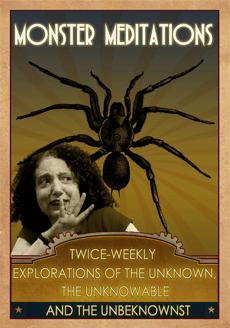Victor Frankenstein, of “Frankenstein or The Modern Prometheus” by Mary Shelley, Herbert West, of “Herbert West — The Reanimator” by H.P. Lovecraft, Dr. Moreau of “The Island of Dr. Moreau” by H. G. Wells, Griffin, AKA The Stranger of “The Invisible Man”, also by H. G. Wells, and Lex Luthor of “Superman” by Jerry Siegel, are just a few of the MAD SCIENTISTS that jump to mind.
Some mad scientists want to take over the world, control weather, create monstrous weapons, seek revenge or simply defy the laws of physics. When they create MONTERS things get out-of-control very quickly!
Some of the best monster stories start with the desire of the mad scientist to improve on mankind or to circumvent the usual way people get “made.” Umm… you’ve got to wonder about that one. The usual way has been doing a good job of producing people for a long, long time. Using science and technology to aid in conception is one thing, using science and technology to make a new and improved version of us, usually creates something monstrous (bigger, faster, stronger, smarter) but not really BETTER and more than a little MONSTROUS.
If the lessons of science fiction stories are anything to go by, the mad scientists never get it right. This, of course, started me pondering an entirely different kind of “successful” monster creation.
Let’s just imagine that a mad scientist succeeded. Picture a patchwork “Frankenstein” who wasn’t ugly, odd and immediately rejected by natural humans. Maybe one of Moreau’s experiments turned out right — right enough to slip outside his island and mix and mingle in the “real” world. What if the invisible Griffin got a job in charge of research and development at a big pharmaceutical company? Would the rest of us be able to identify the monsters among us?
I’ve met a few house cats that seemed to have a bit extra going for them — a dash of chimpanzee or a little bit of tiger? Maybe the mad Moreau was successful?





Reached you by chance – normal with billion plus sites. Some monsters are disguised as humans and move among us unkown. Others are late-developers and only develop physical and mental characteristics late in life. You may know some and be unaware of it.
Glad you found me. Just ran into a neighbor at my local coffee bar. Raising the level of wonderment about the MONSTERS among us.
Any thoughts on the Mad Scientist part of the equation, please do chime in!
I personally think mad scientists are neat, and a lot of sci-fi, fantasy, and horror would be boring without them. I like, though, the idea of a ‘mad’ scientist who got it right. Recently did a short story about a zombie who isn’t into eating people and wants to take full advantage of his ‘second shot’ at life. Maybe I’ll put a mad scientist in one of my mystery novels and see what happens. Great blog.
I love your new zombie concept! With all the re-writing of the vampire & werewolf mythologies, it’s time to refocus the zombies.
It’s true, mad scientists are a lynchpin for many great science fiction (and other genre) stories. The wonderful obsessive nature of Griffin (Invisible Man) often drive the narrative. Without that outsized need to create, change, explore…. not much of a story left.
How about a ‘mad scientist’ who is sane, with the world mad around him/her? Actually, how about a mad scientist who isn’t male?
Yes, it’s about time we had a perfectly sane — and yet compelling — female scientist in genre fiction. As it happens, I’m working on one right now! LOL…. still in it’s early stages, but she’s the protagonist of one of my upcoming Candy’s Monsters.
I guess the concept is in the air!
“using science and technology to make a new and improved version of us, usually creates something monstrous (bigger, faster, stronger, smarter) but not really BETTER and more than a little MONSTROUS.”
I couldn’t help substituting genetically engineered food for the ‘us’ in that sentence. The scientists may be sane but the megalomaniacs pushing the research are my idea of monstrous and who knows what the long term effects will be? Sorry, I know this is completely off topic but I am a little obsessed because good food is so important to me. 🙁
I’m with you on that and I can’t see any upside to a bigger, faster, stronger carrot!
All joking aside, the engineering of plants and animals is scary too. From the susceptibility of farmed fish to diseases that can then be introduced to wild fish populations to the genetically altered bug tomatoes that may inspire transformations in insect genetics — it’s all super scary and reminiscent of those 1950s science fiction movies about nuclear fallout causing gigantic ants to fly like bombers across the sky.
Love the whole mad scientist thing! As long as they stay confined to the pages of a sci fi book of course…all the best with your work.
I agree! Keep those mad scientists MAD and FICTIONAL!
Rather interestingly, in my blog (ianmillerblog.wordpress.com) I regarded Griffin as sane, although eventually driven to the limits by the mess he got himself into. My view is that there is also plenty of scope in stories for the “sane scientist”, although I suppose that assumes that I myself am sane.
Sanity is relative in the world of genre fiction. I think Griffin was a bit mad to begin with — maybe because he felt rejected as an albino — but his obsessive quest to discover the recipe for invisibility was his true madness.
Sane or mad, these scientists are fun!